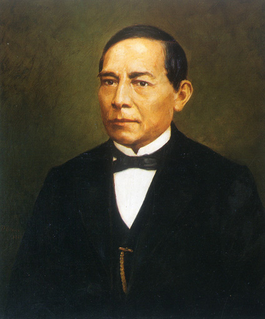
Benito Pablo Juárez García was a Mexican lawyer and politician, who served as the 26th president of Mexico from 1858 until his death in 1872. He was the first president of Mexico who was of indigenous origin. Born in Oaxaca to a poor Zapotec rural family and orphaned young, he moved to Oaxaca City at the age of 12 to go to school. He was aided by a lay Franciscan, and enrolled in seminary, later studying law at the Institute of Sciences and Arts and becoming a lawyer. After being appointed as a judge, in his 30s he married Margarita Maza, a socially prominent woman of Oaxaca City. From his years in college, he was active in politics. Appointed as head justice of the nation's Supreme Court, Juárez identified primarily as a Liberal politician. In his life, he wrote briefly about his indigenous heritage.
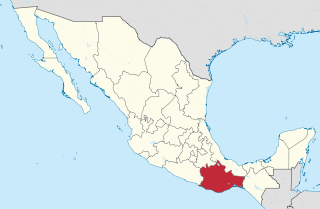
Oaxaca, officially the Free and Sovereign State of Oaxaca, is one of the 32 states that compose the Federative Entities of Mexico. It is divided into 570 municipalities, of which 418 are governed by the system of usos y costumbres with recognized local forms of self-governance. Its capital city is Oaxaca de Juárez.
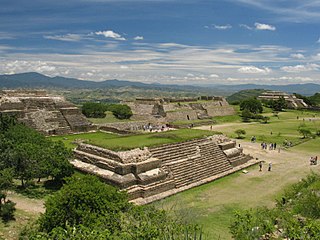
The city and municipality of Oaxaca de Juárez, or Oaxaca City, is the capital and largest city of the eponymous Mexican state. It is in the Centro District in the Central Valleys region of the state, in the foothills of the Sierra Madre at the base of the Cerro del Fortín, extending to the banks of the Atoyac River. Heritage tourism makes up an important part of the city's economy, and it has numerous colonial-era structures as well as significant archeological sites and elements of the continuing native Zapotec and Mixtec cultures. The city, together with the nearby archeological site of Monte Albán, was designated in 1987 as a UNESCO World Heritage Site. It is the site of the month-long cultural festival called the "Guelaguetza", which features Oaxacan dance from the seven regions, music, and a beauty pageant for indigenous women.

Monte Albán is a large pre-Columbian archaeological site in the Santa Cruz Xoxocotlán Municipality in the southern Mexican state of Oaxaca. The site is located on a low mountainous range rising above the plain in the central section of the Valley of Oaxaca, where the latter's northern Etla, eastern Tlacolula, and southern Zimatlán and Ocotlán branches meet. The present-day state capital Oaxaca City is located approximately 9 km (6 mi) east of Monte Albán.

The Isthmus of Tehuantepec is an isthmus in Mexico. It represents the shortest distance between the Gulf of Mexico and the Pacific Ocean. Prior to the opening of the Panama Canal, it was a major overland shipping route known simply as the Tehuantepec Route. The name is taken from the town of Santo Domingo Tehuantepec in the state of Oaxaca; this was derived from the Nahuatl term Tēcuāntepēc.

Oaxaca cheese, also known as quesillo, is a white, semihard cheese that originated in Mexico. It is similar to unaged Monterey jack, but with a texture similar to mozzarella or string cheese.

The Tehuantepec jackrabbit is easily distinguished from other species of jackrabbits by two black stripes that run from the base of the ears to the nape, and by its white flanks. Underparts are white, upperparts are bright-brown washed with black, rump is gray, and the tail is black. This leporid is one of the largest jackrabbits and has large ears and legs. Adults weigh about 3500 to 4000 grams.
Events in the year 1839 in Mexico.

Telanthophora is a genus of Mesoamerican plants in the groundsel tribe within the daisy family.
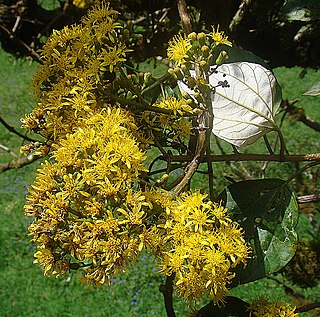
Sinclairia is a genus of Latin American plants in the Liabeae tribe within the daisy family.

Chaetymenia is a genus of flowering plants in the daisy family.

The 2012 Guerrero–Oaxaca earthquake struck southern Mexico with a moment magnitude of 7.4 at on Tuesday, 20 March. Its epicenter was near Ometepec, in the border between the states of Guerrero and Oaxaca. With a shallow focus of 15 to 20 km, the earthquake caused strong shaking over a large area along the Oaxaca–Guerrero border and the adjacent Pacific coastline. Significant tremors were felt in areas up to several hundred kilometers away, including Mexico City and also in Guatemala. Two people were killed and over 30,000 houses were damaged or destroyed.
Berberis moranensis is a shrub in the genus Berberis in the family Berberidaceae. Because of its compound leaves, some botanists place it in the genus Mahonia. It is native to forested regions of the mountains of Mexico from Sinaloa and Guanajuato to Oaxaca. Berberis moranensis has thick waxy leaves, yellow flowers, and purple berries. This species is closely related to Berberis pimanaJ.E. Laferr. & J.S. Marr.
Berberis chochoco is an evergreen shrub or small tree up to 9 m (30 ft) tall, in the genus Berberis, family Berberidaceae. It is native to mountainous regions of northeastern Mexico, in the states of Nuevo León, Veracruz, and San Luis Potosí.

Mahonia gracilis is a plant species native to the Mexico, widely distributed from Tamaulipas to Oaxaca.
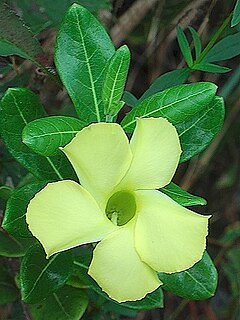
Pentalinon is a genus of flowering plants in the family Apocynaceae, first described as a genus in 1845. It is native to the West Indies, Central America, Mexico, and Florida.
Pherotrichis is a plant genus in the family Apocynaceae, first described as a genus in 1838. It is native to Mexico and Arizona.
- Pherotrichis leptogeniaB.L.Rob. - Jalisco
- Pherotrichis mixtecanaBrandegee - Oaxaca
- Pherotrichis schaffneriA.Gray - San Luis Potosí, Cochise County in Arizona

Berberis tenuifolia is a shrub in the family Berberidaceae described as a species in 1838. It is native to Cuba and Mexico.
Berberis lanceolata is a shrub in the Berberidaceae described as a species in 1840. It is endemic to Mexico, found in the States of Hidalgo, Oaxaca, Veracruz, and Puebla.
Berberis pallida is a shrub in the Berberidaceae described as a species in 1840. It is endemic to Mexico, known from the States of Guanajuato, Hidalgo, Oaxaca, Veracruz, Puebla, Querétaro, and Tamaulipas.













